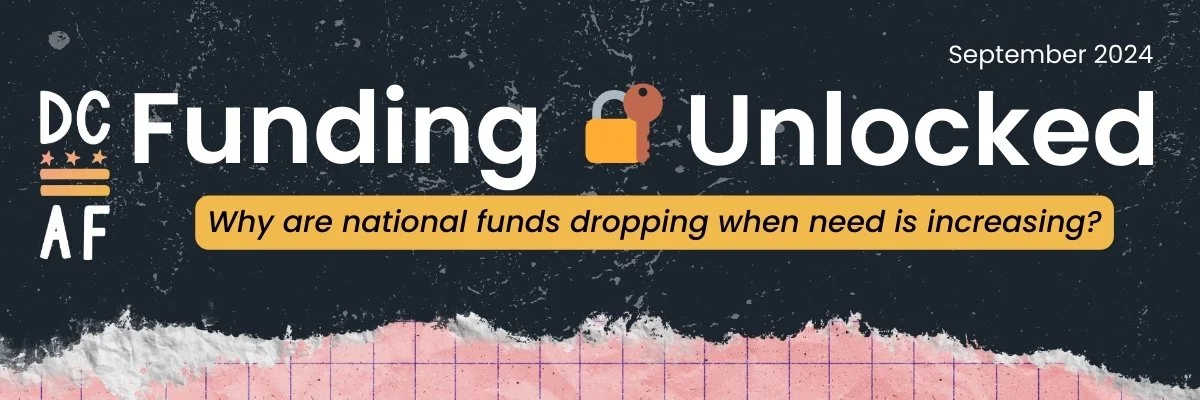Funding Unlocked: Why is national funding dropping when need is increasing?
Welcome to our 🔐 Funding Unlocked 🔐 Series.
You may have caught wind of big changes happening in the abortion funding landscape. We’re here to give you the inside scoop about systemic barriers we face, deep dives into the impact of the Dobbs decision, the spike in out-of-state patients, the financial and logistical challenges we navigate daily — and how we can move through the hard parts together.
This series is about unlocking new conversations, solutions, and funding sources. It starts with a transparent look at the current landscape of abortion funding in DC and beyond.
Why are national groups dropping funds when need is increasing?
In July 2024, local abortion funds across the U.S. faced a crisis as major national organizations like the National Abortion Federation (NAF) and Planned Parenthood slashed their financial assistance programs, leaving us to scramble and fill the gaps. Rewire called this “pure hell” for abortion funds.
These cuts, which were announced with little warning, drastically reduced the amount of support available to abortion seekers, leading to a surge in emergency funding appeals from local funds like DC Abortion Fund. The situation has left us overwhelmed and questioning the priorities of well-funded national groups as we struggle to meet the escalating demand with limited resources. Along with other fund leaders, DCAF is calling for a reevaluation of how resources are distributed, emphasizing that local funds, with their deep community ties and on-the-ground expertise, are better equipped to handle the growing crisis.
Here’s the letter we co-wrote with our allied abortion funds calling out the alarming disconnect between well-funded national organizations and the grassroots efforts providing actual abortion access.
As national groups divert millions into electoral strategies and vague promises, local funds are left struggling to meet immediate needs with limited resources. The message is clear: abortion funds are on the front lines, and the real work of ensuring access happens at the community level.
Now, more than ever, donations should go directly to local funds to support abortion seekers in real-time, not distant political agendas.
What local numbers tell us
The need is growing due to increased travel expenses, delays, and policies in states where abortion is banned. First trimester abortions cost around $500 and rise weekly. Abortion funds aim to get the money directly to seekers, no matter what. Abortion funds provide direct support, arranging financial and practical aid. We're taking calls and making moves to get people their abortions.
Our friends at Baltimore Abortion Fund (BAF) have faced the hard reality of cutting their monthly funding significantly. This decision means that even more people will turn to surrounding abortion funds, including DCAF, to fill the gaps. If you’re able, please consider supporting BAF this month to help them continue their vital work. Donate to BAF.
Funding is declining due to national trends, issue fatigue, and stigma. DCAF’s budget has experienced a drop in donations since the initial rise in donations in response to Dobbs. In the last year, we raised $1.7 million and spent nearly 90% of that on abortion patients. As we said in a recent HuffPost article:
“There is still this internal barrier to wanting to fund abortions directly. Some people will do it in different ways: They’ll give money to a practical support network... or they’ll give money to Planned Parenthood, but they won’t give money to something that they know explicitly goes to funding abortion… We shouldn’t be in a constant state of crisis and panic because we’re here to support people who are already scrambling. But here we are, fighting for resources and asking questions like: ‘Will we have jobs in the future? Will we exist?’”From annual report data, DCAF had ~600 callers in June 2024. If we had the most ideal circumstances and were funding just the most basic of abortion care at $500, to fund everyone who needed us would be about $300,000 a month. But the reality is we are facing extreme bans, increased appointment wait times and ever more complex cases. The gap is huge.
🔐Unlock Abortion Funding: Your First Action
We’re inviting you to take action in a way that works for you. Here are four ways you can help us unlock abortion funding based on the information we’ve shared in the first email of our Unlocking Funding series.
🔑Start a Conversation: Share the graphic below on your social media and start a conversation with your people.
🔑Get in Relationship: Become a monthly donor at any amount. $5/mo is a great starting point. If you can afford it, $25/mo would make a huge difference because it really adds up.
🔑Write us a Love Note: Send us an email with positive thoughts to keep staff and going. We do get harassing emails, so we need the occasional encouraging message.
Next month, we’ll talk about abortion funding at the intersection of policy and narrative. You may have seen that abortion storytellers got primetime coverage at the DNC or mentioned in the recent debate — and we still have a long way to go when it comes to policy & narrative. What do politicians really mean when they say something is “up to the states?” Why wouldn’t we want to “Restore Roe?” What does it mean when a politician doesn’t say “abortion” at all?






